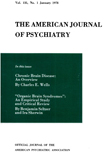Mental Illness in the Biological and Adoptive Families of Adopted Schizophrenics
Abstract
Adoption has been used as a means of separating genetic and environmental factors in the transmission of schizophrenia among family members. In the study reported here, a significantly higher than usual prevalence of schizophrenia-related illness was found among the biological relatives of adopted schizophrenics, but not among their adoptive relatives. The findings support a genetic transmission of vulnerability to schizophrenia, but also imply the requirement of nongenetic, environmental factors for the development of clinical schizophrenic illness.
Access content
To read the fulltext, please use one of the options below to sign in or purchase access.- Personal login
- Institutional Login
- Sign in via OpenAthens
- Register for access
-
Please login/register if you wish to pair your device and check access availability.
Not a subscriber?
PsychiatryOnline subscription options offer access to the DSM-5 library, books, journals, CME, and patient resources. This all-in-one virtual library provides psychiatrists and mental health professionals with key resources for diagnosis, treatment, research, and professional development.
Need more help? PsychiatryOnline Customer Service may be reached by emailing [email protected] or by calling 800-368-5777 (in the U.S.) or 703-907-7322 (outside the U.S.).



